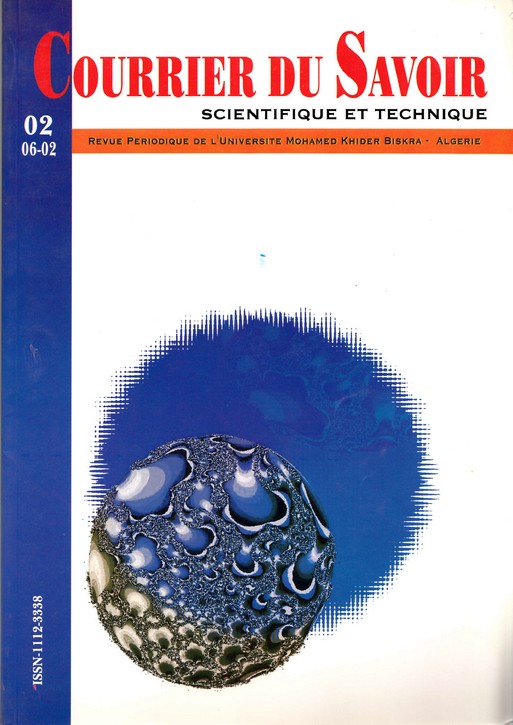COMMANDE ET STABILITE DES SYSTEMES LINEAIRES FLOUS DE TAKAGI-SUGENO
Résumé
Dans cet article, on présente un algorithme pour la conception d’un contrôleur linéaire stabilisant une classe de
systèmes flous. Les systèmes en question sont du type Takagi-Sugeno, caractérisés par une représentation
linéaire du type x A x B u j j & = + . Cet algorithme exploite les modèles locaux du système, obtenus autour de points
de fonctionnement et établis par l’expertise humaine sous la forme de règles de type IF-THEN. La mise en oeuvre de
l’algorithme exige la stabilité, au sens de Lyapunov, d’au moins un modèle local (Aj, Bj). L’algorithme ainsi
développé est appliqué à un robot manipulateur à un degré de liberté. Les simulations sont réalisées sous
l’environnement MATLAB 5.3.
Références
[1] H. Bühler, «Réglage par logique floue», Presses
universitaires polytechniques romandes, Suisse
1994.
[2] R. Hartani, H.T. Nguyen et B. Bouchon-
Meunier «Sur l’approximation universelle des
systèmes flous», RAIRO-APII-JESA, vol. 30,
n°5, pp. 645-663, 1996.
[3] M. Jamshidi, A. Titli, A. Jadbabaie,
«Guaranteed cost design of continuous-time
Takagi-Sugeno fuzzy Controllers via linear
matrix inequalities», LAAS report n° 98512,
May 1998.
[4] C. Melin et B. Vidilov, «Stabilisation de
systèmes par des contrôleurs flous : Partie I»,
RAIRO-APII-JESA, vol. 30, n°5, pp. 679-705,
1996.
[5] F. Khaber, A. Hamzaoui & J.L. Sculfort
«Contrôle flou et stabilité d’un portique avec
masse suspendue», Proceedings CNRIUT’
2000.
F. Khaber & al.
28
[6] F. Khaber et A. Hamzaoui, «Commande floue
d’un système non linéaire», CIP’2001, 09-11
juin 2001.
[7] B.B. Kook and W. Chul Ham, «Adaptive
Control of Robot Manipulator Using Fuzzy
Compensator», IEEE trans. on Fuzzy Systems,
vol. 8, n° 2, April 2000, pp. 718-737.
[8] J. E. Slotine & W. Li «Applied Nonlinear
Control», Prentice Hall 1991.
[9] Stanislaw .H. Zak, «Stabilizing Fuzzy System
Models Using Linear Controllers», IEEE trans.
on Fuzzy Systems, vol. 7, n° 2, April 1999, pp.
236-240
[10] K. Tanaka and M. Sugeno «Stability Analysis
and Design of Fuzzy Control Systems», Fuzzy
Sets Syst., vol. 45, pp. 135-156, 1992
[11] M.C.M. Teixeira and S.H. Zak, «Stabilizing
Controller Design for Uncertain Nonlinear
Systems Using Fuzzy Models», IEEE trans. on
Fuzzy Systems, vol. 7, n° 2, April 1999, pp.
133-142
[12] C.S. Tseng, B.S. Chen, H.J. Uang, «Fuzzy
tracking control for nonlinear dynamic systems
via T-S fuzzy model», IEEE trans. on Fuzzy
Systems, vol. 9, n° 3, June 2001, pp. 381-392.
[13] L. X. Wang «Fuzzy Systems are universal
Approximators», IEEE trans. on Fuzzy Systems,
vol. 5, n° 8, May 1992, pp. 1164-1173
[14] L. X. Wang, «Stable and Optimal Fuzzy Control
of Linear Systems», IEEE trans. on Fuzzy
Systems, vol. 6, n°1, February 1998, pp. 137-
143.
[15] J. Yoneyama, M. Nishikawa, H. Katayama and
Ichikawa «Output Stabilization of Takagi-
Sugeno fuzzy Systems»,
universitaires polytechniques romandes, Suisse
1994.
[2] R. Hartani, H.T. Nguyen et B. Bouchon-
Meunier «Sur l’approximation universelle des
systèmes flous», RAIRO-APII-JESA, vol. 30,
n°5, pp. 645-663, 1996.
[3] M. Jamshidi, A. Titli, A. Jadbabaie,
«Guaranteed cost design of continuous-time
Takagi-Sugeno fuzzy Controllers via linear
matrix inequalities», LAAS report n° 98512,
May 1998.
[4] C. Melin et B. Vidilov, «Stabilisation de
systèmes par des contrôleurs flous : Partie I»,
RAIRO-APII-JESA, vol. 30, n°5, pp. 679-705,
1996.
[5] F. Khaber, A. Hamzaoui & J.L. Sculfort
«Contrôle flou et stabilité d’un portique avec
masse suspendue», Proceedings CNRIUT’
2000.
F. Khaber & al.
28
[6] F. Khaber et A. Hamzaoui, «Commande floue
d’un système non linéaire», CIP’2001, 09-11
juin 2001.
[7] B.B. Kook and W. Chul Ham, «Adaptive
Control of Robot Manipulator Using Fuzzy
Compensator», IEEE trans. on Fuzzy Systems,
vol. 8, n° 2, April 2000, pp. 718-737.
[8] J. E. Slotine & W. Li «Applied Nonlinear
Control», Prentice Hall 1991.
[9] Stanislaw .H. Zak, «Stabilizing Fuzzy System
Models Using Linear Controllers», IEEE trans.
on Fuzzy Systems, vol. 7, n° 2, April 1999, pp.
236-240
[10] K. Tanaka and M. Sugeno «Stability Analysis
and Design of Fuzzy Control Systems», Fuzzy
Sets Syst., vol. 45, pp. 135-156, 1992
[11] M.C.M. Teixeira and S.H. Zak, «Stabilizing
Controller Design for Uncertain Nonlinear
Systems Using Fuzzy Models», IEEE trans. on
Fuzzy Systems, vol. 7, n° 2, April 1999, pp.
133-142
[12] C.S. Tseng, B.S. Chen, H.J. Uang, «Fuzzy
tracking control for nonlinear dynamic systems
via T-S fuzzy model», IEEE trans. on Fuzzy
Systems, vol. 9, n° 3, June 2001, pp. 381-392.
[13] L. X. Wang «Fuzzy Systems are universal
Approximators», IEEE trans. on Fuzzy Systems,
vol. 5, n° 8, May 1992, pp. 1164-1173
[14] L. X. Wang, «Stable and Optimal Fuzzy Control
of Linear Systems», IEEE trans. on Fuzzy
Systems, vol. 6, n°1, February 1998, pp. 137-
143.
[15] J. Yoneyama, M. Nishikawa, H. Katayama and
Ichikawa «Output Stabilization of Takagi-
Sugeno fuzzy Systems»,
Comment citer
KHABER, F.; HAMZAOUI, A..
COMMANDE ET STABILITE DES SYSTEMES LINEAIRES FLOUS DE TAKAGI-SUGENO.
Courrier du Savoir, [S.l.], v. 2, avr. 2014.
ISSN 1112-3338.
Disponible à l'adresse : >https://revues.univ-biskra.dz./index.php/cds/article/view/200>. Date de consultation : 26 avr. 2025
Rubrique
Articles


